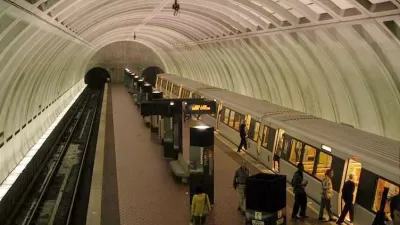TheCityFix's Jonna McKone profiles one of the most interesting subways in the world — Haifa's Carmelit funicular — and the city's BRT system.
The Carmelit system opened in 1959 and has 6 stations along its 1.8-kilometer track that climbs Mount Carmel in Haifa, a coastal city in northern Israel. According to DesignBoom, "the system transports around 2,000 people along the track each day and is among the most unusual subway stations in the world."
The city has a bus rapid transit (BRT) system, called Metronit, in the works. Treehugger wrote about the plan back in 2008. Currently, as we wrote about before, intercity bus travel is one of the most popular ways of getting around Israel. Egged Ltd. is Israel's largest transit bus company and the second largest in the world after London Buses. It operates 945 lines, serving a million passengers daily. About 47 percent of Israeli bus passengers use the service, according to one source.
Despite Haifa's short tramway-like subway and efforts to improve the bus system, there are a ton of traffic problems in the city. The Israeli Finance Ministry says the country loses NIS 20 billion a year (that's about $5.5 billion) due to traffic. And Haifa accounts for 10 percent of these costs. Troubling news for Israel, a recent study found that the "use of public transportation by commuters to and from work declined by 20% between 1995 and 2008, while use of private cars increased by 15%." Israel faces a number of reasons for the increases in car ownership, including tax incentives for the purchase of vehicles, the lack of a national transportation plan and a decline in the number of commuter buses.
Thanks to Garrett Bradford
FULL STORY: In Haifa, a Strange Subway and a New BRT

Manufactured Crisis: Losing the Nation’s Largest Source of Unsubsidized Affordable Housing
Manufactured housing communities have long been an affordable housing option for millions of people living in the U.S., but that affordability is disappearing rapidly. How did we get here?

Americans May Be Stuck — But Why?
Americans are moving a lot less than they once did, and that is a problem. While Yoni Applebaum, in his highly-publicized article Stuck, gets the reasons badly wrong, it's still important to ask: why are we moving so much less than before?

Using Old Oil and Gas Wells for Green Energy Storage
Penn State researchers have found that repurposing abandoned oil and gas wells for geothermal-assisted compressed-air energy storage can boost efficiency, reduce environmental risks, and support clean energy and job transitions.

Greening Oakland’s School Grounds
With help from community partners like the Trust for Public Land, Oakland Unified School District is turning barren, asphalt-covered schoolyards into vibrant, green spaces that support outdoor learning, play, and student well-being.

California Governor Suspends CEQA Reviews for Utilities in Fire Areas
Utility restoration efforts in areas affected by the January wildfires in Los Angeles will be exempt from environmental regulations to speed up the rebuilding of essential infrastructure.

Native American Communities Prepare to Lead on Environmental Stewardship
In the face of federal threats to public lands and conservation efforts, indigenous groups continue to model nature-centered conservation efforts.
Urban Design for Planners 1: Software Tools
This six-course series explores essential urban design concepts using open source software and equips planners with the tools they need to participate fully in the urban design process.
Planning for Universal Design
Learn the tools for implementing Universal Design in planning regulations.
Heyer Gruel & Associates PA
City of Moreno Valley
Institute for Housing and Urban Development Studies (IHS)
City of Grandview
Harvard GSD Executive Education
Salt Lake City
NYU Wagner Graduate School of Public Service
City of Cambridge, Maryland





























